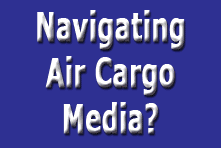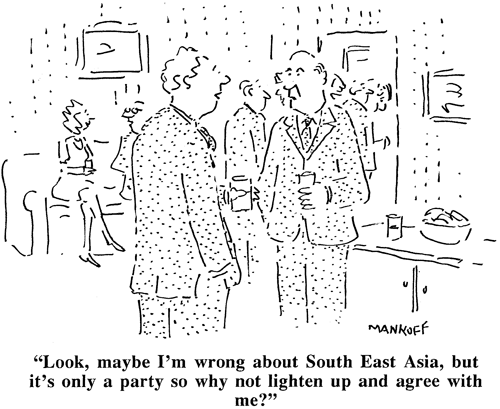
 lying is the safest means of transport as proven by accident statistics,
and that is what regulators and other stakeholders continuously emphasize,
for a reason.
lying is the safest means of transport as proven by accident statistics,
and that is what regulators and other stakeholders continuously emphasize,
for a reason.
Indeed, chances are much higher to get run over in your supermarket’s
parking lot than to be involved in an aircraft accident, even for those
road warriors constantly travelling for business.
However, there are exceptions to this rule.
The “IATA 2012 Safety Performance
Statistics” indicate an all-time low of 0.20 hull losses (which
is the euphemism for an aircraft totally wrecked) per million sectors
for the airline industry in total.
A “sector”, for those not familiar
with the term, is a flight segment uninterrupted by landings from point
A to point B. A flight from, say, Frankfurt to Los Angeles via New York
would hence comprise of two sectors. But there is more.

The IATA statistics (for good reason) are
listing only western-built aircraft, so they’re not all encompassing.
The simple reason for this is that would
these statistics have included accidents involving Russian-built aircraft,
a much less favorable picture would appear.
Still, the statistics prove that flying
in the U.S., Europe, and most parts of Asia has never been safer than
at present.

The numbers also prove that the safety map
has two blind spots: Africa and the CIS States.
There is a multitude of reasons for the
lapse; the most important being lack of oversight by national authorities
in some states; cash-strapped carriers operating old, obsolete, and badly
maintained aircraft; the lack of a safety culture; and lack of training
in all sectors of the aviation business.
Indeed, a number of airlines from African
and CIS states are on the EC “No Fly” list because the governments
tasked with their oversight do not have the necessary means at their disposal.
It is safe to say that all stakeholders
in the aviation business have addressed these issues in the past 10 years
(namely ICAO and IATA) and brought forward a number of safety initiatives
that aim at improving safety records in these parts of the world.
It must be kept in mind that the International
Civil Aviation Organization (ICAO), headquartered in Montreal, is a United
Nations Agency and thus counts the governments involved among their stakeholders.

Subsequently, it is all the more surprising
to look at the unusually high number of accidents and incidents involving
UN-chartered aircraft.
As much as the UN, ICAO, and other stakeholders
call for exchange of information as a best business practice, information
is not easily obtained concerning UN chartered aircraft.
First of all, just looking at a list of
accidents involving such UN charters will tell little. Yes, the figure
is high, but it must also be kept in mind that many of these flights are
operated under very adverse conditions, often in war-stricken areas or
after the occurrence of natural disasters.
Second, those flights often operate to remote
areas where neither paved runways nor appropriate ground equipment exist.
Western-built aircraft, in particular the cargo versions, have to rely
on both in order to operate, while the sturdier Russian-built aircraft
designed with a multi-purpose civil and military use require very little
ground equipment and can operate on gravel strips.
Given those adverse conditions and the remote
locations, a higher accident rate than flights operating between well-equipped
western airports seems reasonable—to a degree.
But even when factoring in these circumstances,
the accident rate involving UN-chartered aircraft remains unusually high.
As for incidents (happenings which had the
potential to endanger aircraft, crew, passengers, other people or property,
and cargo, but fortunately did not result in any of these) there is simply
no way of ascertaining these, since neither the UN nor the governments
involved provide any insight.
It is, however, safe to say that certain
safety precautions required by ICAO and theoretically demanded by the
UN by means of charter contracts are usually not implemented and that
typically neither the UN or UN Mission in question nor the operator has
sufficient operational control to guarantee a safety level as equivalent
to ICAO SARPS (Standards and Recommended Practices) as circumstances would
allow.

A telling posting in a professional pilot’s
forum reads:
“There are two ways to get a UN contract.
One is to broker cheap unsafe ex eastern bloc military aircraft or bribe.
“Any combination of the above is also
acceptable.
“Sometimes you don’t even need
to have the aircraft—just say you do.”
While this statement may be overrated, exaggerated,
or simply untrue, it is still telling; at least it was not challenged
in any way from other pilots in that forum.

The following facts have been established
in regard to UN charters:
 Russian-built and partially technically obsolete aircraft such as
the AN12, AN 24, AN70; Ilyushin IL62, older IL76 types, and IL-86 as well
as Yakovlev YAK-40 and old western Boeing 727’s with questionable
or no maintenance records are frequently in use, although these aircraft’s
maintenance and registration records often do not hold up to even a cursory
check.
Russian-built and partially technically obsolete aircraft such as
the AN12, AN 24, AN70; Ilyushin IL62, older IL76 types, and IL-86 as well
as Yakovlev YAK-40 and old western Boeing 727’s with questionable
or no maintenance records are frequently in use, although these aircraft’s
maintenance and registration records often do not hold up to even a cursory
check.
 UN and UN mission’s personnel (including sub organizations
such as the WFP) have not been briefed about elementary security and safety
measures such as carriage of Dangerous Goods within baggage, aircraft
emergency exits, etc.
UN and UN mission’s personnel (including sub organizations
such as the WFP) have not been briefed about elementary security and safety
measures such as carriage of Dangerous Goods within baggage, aircraft
emergency exits, etc.
 Aircraft crews are sometimes not properly licensed and at times
filed flight plans make it obvious that crew duty times were exceeded
on a scheduled basis.
Aircraft crews are sometimes not properly licensed and at times
filed flight plans make it obvious that crew duty times were exceeded
on a scheduled basis.
 UN missions at times resort to questionable measures, such as proposing
to airlift UXO (unexploded ordnance) from a crisis area, notwithstanding
clear provisions in the UN’s own “UN Landmine Handbook”
UN missions at times resort to questionable measures, such as proposing
to airlift UXO (unexploded ordnance) from a crisis area, notwithstanding
clear provisions in the UN’s own “UN Landmine Handbook”
 The prime criterion when selecting an operator seems to be the tender
price. Safety records of the operator and the ability to exercise the
required operational control (thus meeting applicable ICAO minimum safety
standards to which the UN at least verbally commits itself) are apparently
not taken all too much into consideration
The prime criterion when selecting an operator seems to be the tender
price. Safety records of the operator and the ability to exercise the
required operational control (thus meeting applicable ICAO minimum safety
standards to which the UN at least verbally commits itself) are apparently
not taken all too much into consideration
 The reputation of an operator also does not seem to play a big role—various
UN missions had contracted Kazakhstan-registered Irbis Air, owned by alleged
arms dealer “Lord of War” Viktor Anatolyevich Bout, to supply
airlift capacity, resulting in Bout profiting both from the supply of
arms into war areas such as Liberia and Angola and from the relief mission
supply following it.
The reputation of an operator also does not seem to play a big role—various
UN missions had contracted Kazakhstan-registered Irbis Air, owned by alleged
arms dealer “Lord of War” Viktor Anatolyevich Bout, to supply
airlift capacity, resulting in Bout profiting both from the supply of
arms into war areas such as Liberia and Angola and from the relief mission
supply following it.
Maintaining the aforementioned “operational
control” is far more important than it might seem.

One factor that played a vital role in at
least two accidents involving UN-chartered aircraft was inaccurate trim
(weight and balance) and/or overweight of the aircraft resulting from
inaccurate establishment of the loaded cargoes’ actual gross weight,
and/or the crew accepting bribes to carry undocumented, private, or commercial
cargoes of unknown nature, according to a source close to the matter who
wishes to remain unnamed.
However, the July 8th, 2011, crash of Hewa
Bora Airlines flight 952 (which was not in any way affiliated with the
UN or one of its missions) in Kisangani, DRC, might serve as an example
of what to expect.
The accident aircraft, an ex-Lufthansa 727-30,
had no maintenance records to speak of, both the accident captain and
the tower controller turned out not to have been licensed, the tower communication
was not recorded since both recorders were broken, and the tower gave
out a false weather report; altogether it resulted in the loss of 75 lives.
The carriage of “undocumented”
passengers aboard aircraft in Africa is also an issue for flights under
UN charter, the source confirmed – either because the mostly African-based
and underpaid crew was paid to turn a blind eye, or because people hide
in the cargo holds.
It is also safe to say that the UN and its
missions apparently do not carry out the bare minimum of “due diligence”
regarding the service providers of air transport capacity, which would
be expected from any privately held company:
An Airzena Georgian Airways CRJ-100, registration
4L-GAE, which was under charter for the UN as flight 834 from Kisangani
to Kinshasa N'Djili, DRC, crashed after a missed approach in Kinshasa,
resulting in the death of all four crew and 28 of the total 29 passengers
in UN employ on April 4th, 2011.
On November 18th, 2010, however, the CAA
of Georgia communicated the following brief to all civil aviation authorities
worldwide.
“Dear Colleagues,
Georgian registered CL-600-2B19 Reg:4L-GAE
operated in Republic of Congo by A/C ‘Georgian Airways’
flight operation has been prohibited from 18.11.2010 due to suspension
of certificate of airworthiness. Please inform relevant Aviation Authorities
to ground above-mentioned aircraft until additional official permission
from the United Transport Administration of Georgia.
Shalva Kiknadze, Head of Flight Standards, Certification and Inspection
Division"
|

Given the risky circumstances of such operations,
it would seem wise for certain safety precautions to be taken from the
UN side. These, however, amount to not much more than limiting the liability
of the UN towards the operator to $100,000 USD, subparagraph 3.1 of the
UN standard short-term charter agreement reads:
“3.1 In consideration of the complete and satisfactory provision
by the Carrier of all of the services under this Agreement, the UN shall
pay the Carrier the sums, in the manner and at the times, provided for
in the Payment Schedule set forth in Annex B, hereto. The foregoing notwithstanding,
in no event shall the UN pay the Carrier for all the services to be provided
hereunder a total price in excess of US DOLLARS -- HUNDRED THOUSAND HUNDRED
AND (US$ --), which shall constitute the maximum monetary liability of
the UN to the Carrier under this Agreement.
Help, so it seems, is expensive, but covering
the risks of help in developing nations comes cheap.
Jens
|







